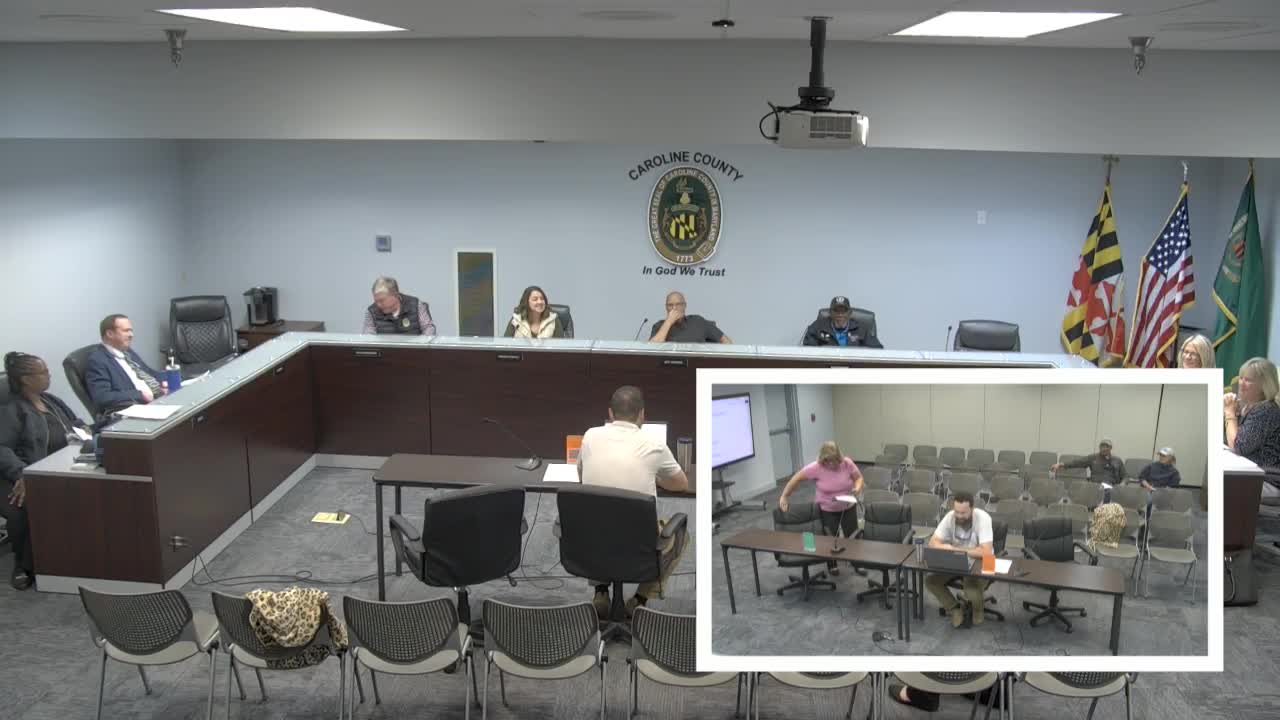Caroline planning commission backs compensatory preservation fund and solar regulation updates; recommends 75% MALPF appraisal basis
October 09, 2025 | Caroline County, Maryland
This article was created by AI summarizing key points discussed. AI makes mistakes, so for full details and context, please refer to the video of the full meeting. Please report any errors so we can fix them. Report an error »

The Caroline County Planning Commission on Wednesday voted to recommend establishing an agricultural compensatory preservation contribution fund and to update local solar regulations to align with state law, directing staff to use Maryland Agricultural Land Preservation Foundation (MALPF) fair‑market appraisals as the valuation basis and to apply a 75% payment rate to affected acreage at final site plan approval.
Planning staff and commissioners said the two actions were linked: the county is seeking to recover a community benefit when productive farmland is converted to large‑scale solar projects as required by recent state renewable energy law. The commission moved to recommend draft language creating a compensatory preservation fund and to adopt regulatory cleanup that defers larger siting and landscaping standards for projects one megawatt or greater to state code while retaining local review and the compensatory fund for county review.
Donna David Smith, agricultural specialist from Queen Anne's County, described her county������������������� program and how MALPF appraisals inform payments. "The biggest concern of the county commissioners in Finance County was how do we do this and not get sued?" she said, explaining Queen Anne's adopted an approach that uses MALPF appraisal averages and a 75% cap consistent with COMAR MALPF guidance. Smith told the commission MALPF appraisals are public on a lag and are based on raw land values from MALPF easement cycles; she said deference to MALPF appraisals reduces legal risk and administrative burden.
Commissioners discussed which soils and acreage to include. After debate, the commission recommended using soils mapping consistent with MALPF (prime farmland and farmland of statewide importance, discussed as Class 1 and Class 2 soils) and applying the 75% MALPF‑based figure to the project's limit of disturbance (the whole project area used for construction, roads, fencing, staging) at final site plan approval. Commissioners said the choice balances defensibility and fairness: using MALPF appraisals reduces exposure to legal challenge, while focusing on Class 1/2 soils recognizes where the highest agricultural value lies.
On procedure, the commission directed staff to rely on the most recent MALPF fair‑market appraisals available at the time of final site plan approval; if MALPF data are unavailable or the methodology changes, staff would return with alternatives. The commission also voted to recommend Legislative Bill 2025‑012, which updates local solar siting language to conform with the state Renewable Energy Siting Act and explicitly ties the compensatory fund into county review.
The motions passed by voice vote; one commissioner abstained from the compensatory fund vote. Staff were asked to return with draft ordinance text and to brief county commissioners and legal staff ahead of the county commission's review.
Planning staff and commissioners said the two actions were linked: the county is seeking to recover a community benefit when productive farmland is converted to large‑scale solar projects as required by recent state renewable energy law. The commission moved to recommend draft language creating a compensatory preservation fund and to adopt regulatory cleanup that defers larger siting and landscaping standards for projects one megawatt or greater to state code while retaining local review and the compensatory fund for county review.
Donna David Smith, agricultural specialist from Queen Anne's County, described her county������������������� program and how MALPF appraisals inform payments. "The biggest concern of the county commissioners in Finance County was how do we do this and not get sued?" she said, explaining Queen Anne's adopted an approach that uses MALPF appraisal averages and a 75% cap consistent with COMAR MALPF guidance. Smith told the commission MALPF appraisals are public on a lag and are based on raw land values from MALPF easement cycles; she said deference to MALPF appraisals reduces legal risk and administrative burden.
Commissioners discussed which soils and acreage to include. After debate, the commission recommended using soils mapping consistent with MALPF (prime farmland and farmland of statewide importance, discussed as Class 1 and Class 2 soils) and applying the 75% MALPF‑based figure to the project's limit of disturbance (the whole project area used for construction, roads, fencing, staging) at final site plan approval. Commissioners said the choice balances defensibility and fairness: using MALPF appraisals reduces exposure to legal challenge, while focusing on Class 1/2 soils recognizes where the highest agricultural value lies.
On procedure, the commission directed staff to rely on the most recent MALPF fair‑market appraisals available at the time of final site plan approval; if MALPF data are unavailable or the methodology changes, staff would return with alternatives. The commission also voted to recommend Legislative Bill 2025‑012, which updates local solar siting language to conform with the state Renewable Energy Siting Act and explicitly ties the compensatory fund into county review.
The motions passed by voice vote; one commissioner abstained from the compensatory fund vote. Staff were asked to return with draft ordinance text and to brief county commissioners and legal staff ahead of the county commission's review.
View full meeting
This article is based on a recent meeting—watch the full video and explore the complete transcript for deeper insights into the discussion.
View full meeting
